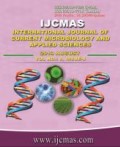


 National Academy of Agricultural Sciences (NAAS)
National Academy of Agricultural Sciences (NAAS)

|
PRINT ISSN : 2319-7692
Online ISSN : 2319-7706 Issues : 12 per year Publisher : Excellent Publishers Email : editorijcmas@gmail.com / submit@ijcmas.com Editor-in-chief: Dr.M.Prakash Index Copernicus ICV 2018: 95.39 NAAS RATING 2020: 5.38 |
Cultural and morphological variability studies on three different media viz., Potato Dextrose Agar, Richard’s Synthetic Agar and Czapek’s Dox Agar revealed considerable variation among the isolates of A. burnsii indicated the existence of variability in the pathogen. Moreover, Potato Dextrose Agar and Czapek’s Dox Agar were found as an excellent media to support the growth and spore formation of isolates of A. burnsii, respectively. Initially, the fungal growth was light green, sometimes whitish green septate mycelial growth and finally grey to black in color with dirty white to brownish colony margin and fluffy radial, plain irregular radial and fluffy knotting growth pattern on three different media. Among fifteen isolates of A. burnsii, distinct differences in terms of conidial length, breadth, beak length and number of septa were recorded. The average conidial length varied from 50.89 to 63.76µm and breadth ranges from 20.24 to 25.47 µm with beak length of 28.73 to 47.33 µm. The transverse septa varied from 1 to 6 and longitudinal septa varied from to 0 to 3, respectively. In the present studies, glaring differences in conidial size were noticed among the isolates even when same medium was used for the growth of the isolates. It can be assumed that variation in the isolates may be inherent since isolates were collected from diverse agroclimatic zones of Gujarat. Hence, these variations in the conidial size indicated the existence of variability in this pathogen
 |
 |
 |
 |
 |